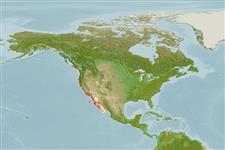>
Atheriniformes (Silversides) >
Atherinopsidae (Neotropical silversides) > Atherinopsinae
Etymology: Atherinops: Greek, atherina, the Greek name for the eperlane; 1770 + Greek, ops = appearance (Ref. 45335); affinis: affinis which means related - in this case to fishes of the genus Atherina (Ref. 6885).
More on author: Ayres.
Environment: milieu / climate zone / depth range / distribution range
Ecologia
marinhas; estuarina; intervalo de profundidade ? - 26 m (Ref. 96339). Subtropical; 52°N - 21°N, 130°W - 105°W (Ref. 96339)
Eastern Pacific: Vancouver Island in British Columbia, Canada to Baja California, Mexico and the Gulf of California.
Tamanho / Peso / Idade
Maturity: Lm ? range ? - ? cm
Max length : 37.0 cm TL macho/indeterminado; (Ref. 9273); common length : 28.0 cm TL macho/indeterminado; (Ref. 9273); Idade máx. registada: 9 anos (Ref. 72477)
Descrição breve
Chaves de identificação | Morfologia | Morfometria
Espinhos dorsais (total) : 6 - 10; Raios dorsais moles (total) : 8 - 14; Espinhos anais: 1; Raios anais moles: 19 - 25; Vértebras: 44 - 52. Blue gray to green above, silvery below; a striking silver band bordered above with blue extends the full length of the body (Ref. 6885). Branchiostegal rays: 5-6 (Ref. 36497).
Common in bays, muddy and rocky areas and kelp beds, also in estuaries (Ref. 36497). Form schools. Adults feed on zooplankton (Ref. 9273), while juveniles feed on algae and kelp fly larvae (Ref. 4930). Demersal spawner in nearshore habitats (Ref. 56049). Oviparous, with planktonic, primarily neustonic larvae (Ref. 36497). Eggs are attached to spawning substrate and to one another by adhesive filaments (Ref. 36497).
Eschmeyer, W.N., E.S. Herald and H. Hammann, 1983. A field guide to Pacific coast fishes of North America. Boston (MA, USA): Houghton Mifflin Company. xii+336 p. (Ref. 2850)
Categoria na Lista Vermelha da IUCN (Ref. 130435: Version 2024-1)
Ameaça para o homem
Harmless
Utilização humana
Pescarias: espécies comerciais
Ferramentas
Can't connect to MySQL database fbquizv2. Errorcode: Too many connections
